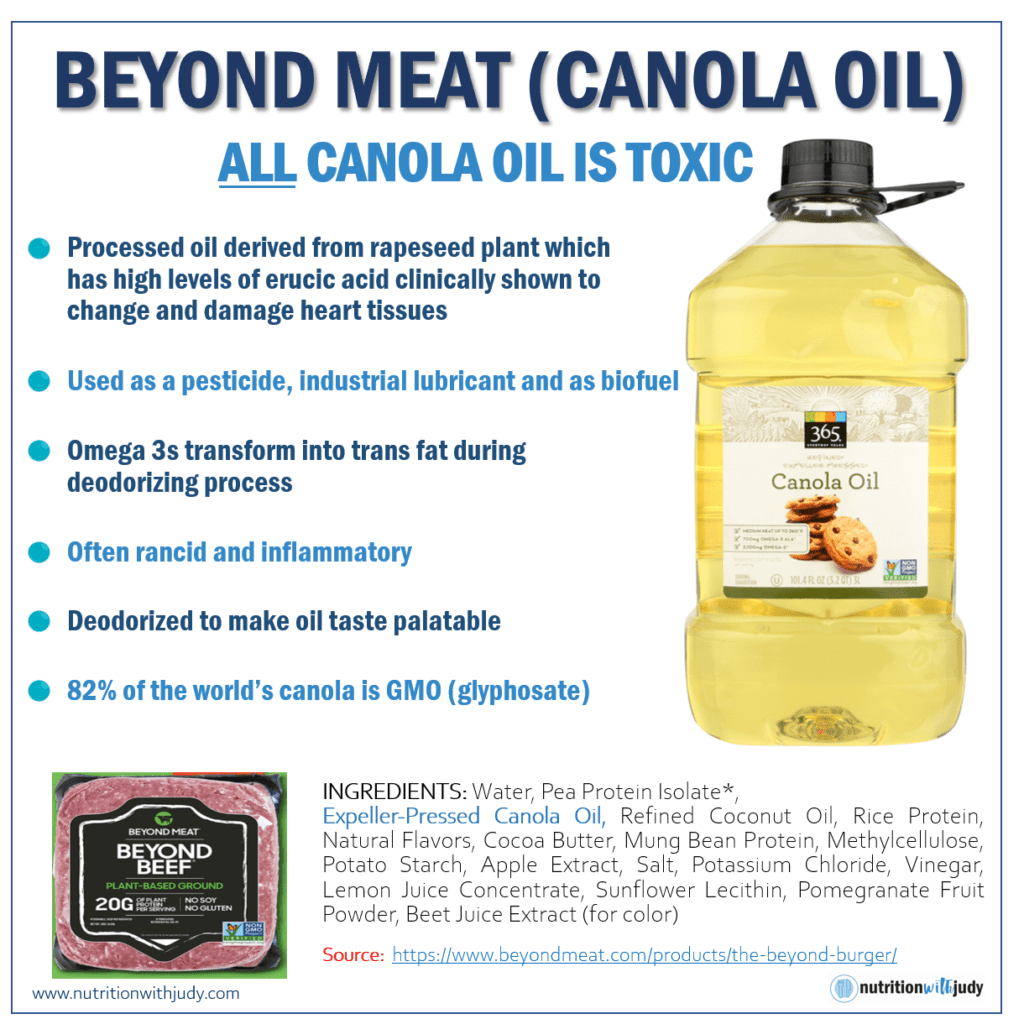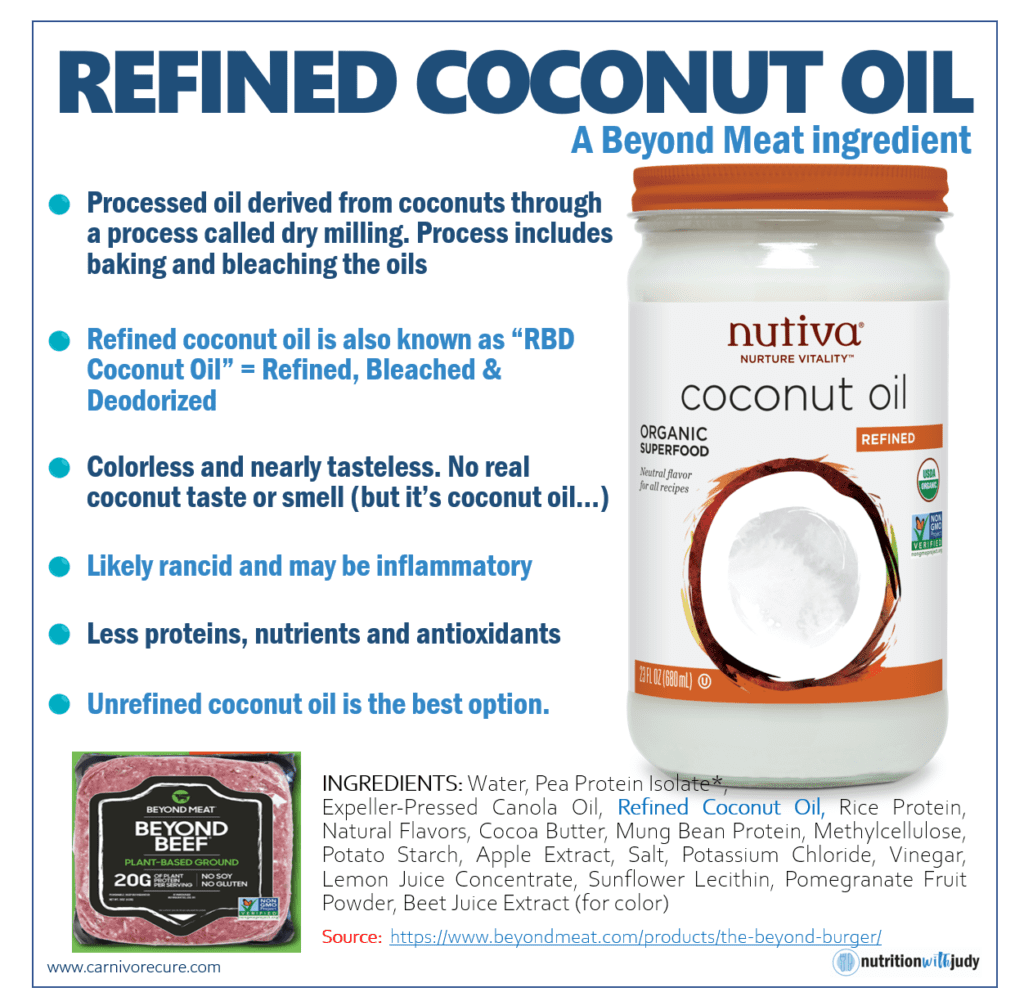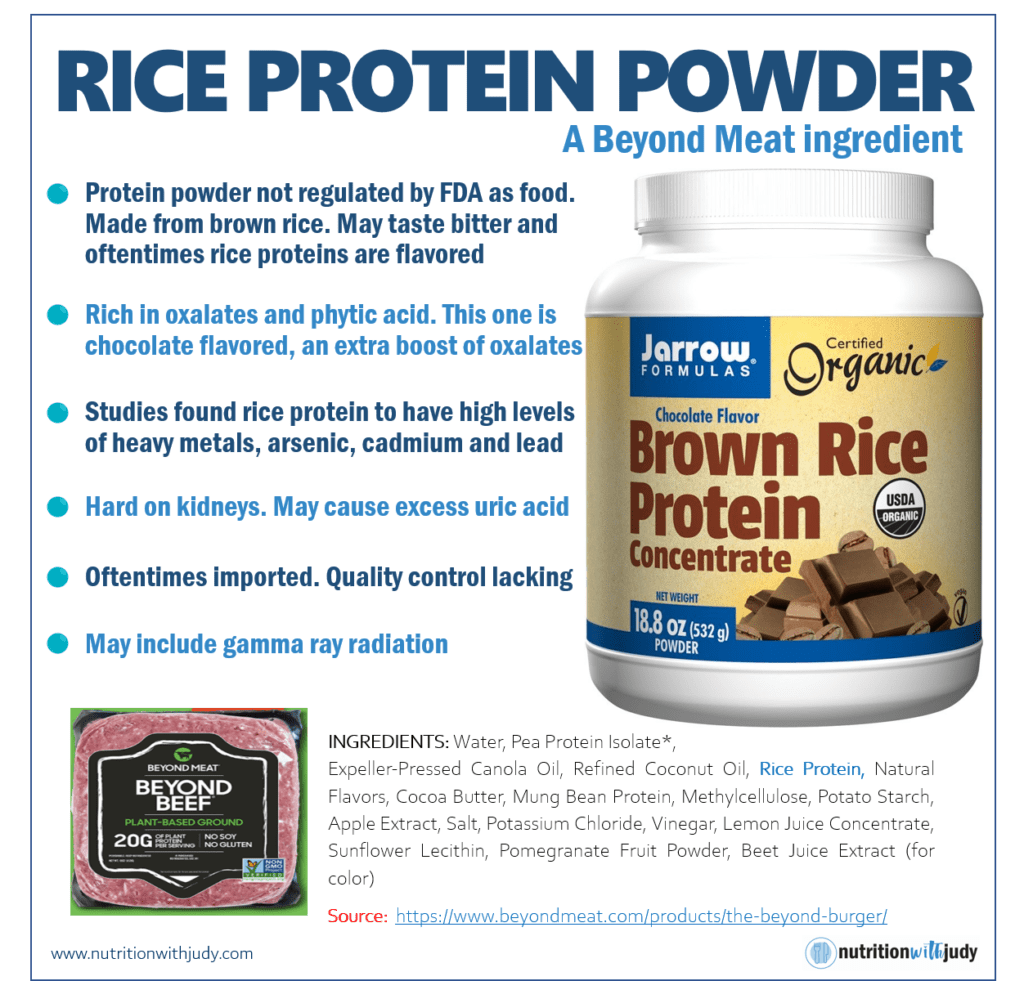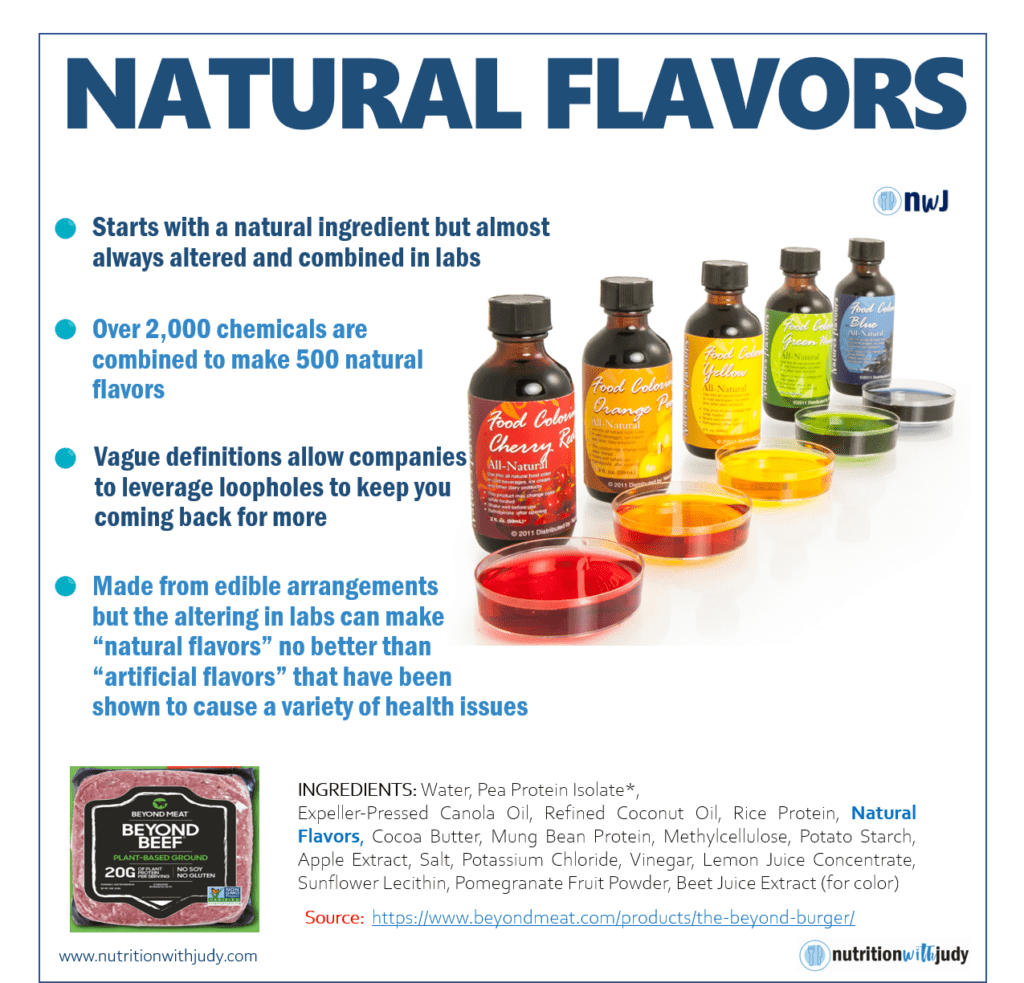

Beyond Meat: Meat-Alternative Solution?


If you are considering eating plant-based meat alternative options because of health, keep reading. If you are eating it because of the climate, I highly recommend reading my blog post on Meat and Climate Change.
Many public figures are advocates of plant-based diets for physical health and for climate change.
Oftentimes, these meat-based alternatives like Beyond Meat never consider the harm of monocropping. In my book, Carnivore Cure, I talk about regenerative agriculture vs. monocrop agriculture (and conventional farming).
One example of monocrop foods is Beyond Meat. Let’s dig into the ingredients.
Pea Protein


The first ingredient is water. I wonder if they are using high-quality water. You can read my post on water here and here.
The next ingredient is pea protein isolate.
Peas can cause food sensitivities. Peas can cause issues with people susceptible to gout. Pea protein does not contain essential fatty acids which are critical for optimal health. It’s likely why Beyond Meat has a legume disclaimer.⠀
As pea protein extracts and powders are not considered food but a supplement, the manufacturers are not required to provide nutritional values. Yes, pea proteins aren’t regulated by the FDA. The FDA only regulates supplements if they are proving to cause harm to the consumer (illness or injury). But as most supplements are self-prescribed, it’s hard to accurately report bad reactions and side effects against supplements. According to Harvard Health Publishing, it’s not even possible to know with certainty if a supplement contains what the manufacturer claims are in the ingredients. (Source, Source)
Extracting proteins from dry peas will most likely remove most nutrients but the manufacturers aren’t responsible to share. These protein powders contain toxins like arsenic, cadmium, and lead and in high amounts. In 2018, the Clean Label Project tested 134 protein powders for 130+ toxins and found that plant-based products were the highest carrier of toxins with 75% of the products testing positive for lead. Add insult to injury you’re left with a heavy dose of allergens in plant proteins and a heavier concentrate of antinutrients. (Source)
According to the USDA nutritional database, to get 27 grams of protein from whole peas, you would have to consume 3.5 cups of peas and 29 grams of fiber. 20 grams of pea protein meat has only 2 grams of fiber.⠀
How is that possible?
People with reduced kidney function and possible gout should be careful before choosing to consume pea protein. Pea proteins are rich in purines and can convert to uric acid. Purines aren’t dangerous in normal amounts but excess amounts can make reduced functioning kidneys have a more difficult time reducing uric acid.⠀
If you want to eat peas, it’s probably best to consume the real thing. Legumes, GMOs, antinutrients, and all, at least peas are still a real food.
Meat vs Beyond Meat: Price Per Pound
Yet marketing is so good that eating meat substitutes costs more $ per lb. than grass-fed meats.
On overage, grass-fed meat costs about $6 per pound for grass-fed ground beef. Conventional meat costs about $4 per pound. Beyond meat, on average costs closer to $10 per pound.
We say we can’t afford grass-fed meats but we easily fork over money for these meat-alternatives that are so damaging to health.
Canola Oil


I have a blog post on seed oils and why they are toxic to your health. But here’s a brief summary.
Oils are extracted from vegetables in the following ways:⠀
- Chemical solvents (hexane)⠀
- Centrifuge⠀
- Expeller-pressed⠀
Canola oil is extracted from rapeseed plants that have been bred to have lower levels of toxic erucic acid. Rapeseed Oil causes heart damage in animal studies. While the new name of rapeseed is canola, it still contains trace amounts of erucic acid (up to 2% is considered safe). (Source)
⠀
In 1995, Genetically Modified Organisms (GMOs) were introduced to rapeseed and almost all canola crops in North America are now of the GMO variety. Canola oil consumption has been linked to vitamin E deficiency and a shortened life span. The process of deodorizing canola oil to make the oil palatable transforms Omega 3s into trans fats. (Source)
⠀
And the disturbing part is that these trans fats are not labeled. The nutritional guidelines permit anything under 0.5g per serving to be labeled as zero.
Just because it says 0 trans fats does not mean there is no trans fats.
Expeller-Pressed and Hexane
Expeller-pressed is when the plant seeds are crushed and heated and 65-70% of the oil is yielded during this time. The remaining oil is pulled out using chemical solvents like hexane. Hexane is poisonous.
But manufacturers assure consumers that all hexane is removed.
According to Harvard’s School of Public Health,
“It has been estimated that refined vegetable oils extracted with hexane contain approximately 0.8 milligrams of residual hexane per kilogram of oil (0.8 ppm). It is also estimated that the level of ingestion of hexane from all food sources is less than 2% of the daily intake from all other sources, primarily gasoline fumes. There appears to be very little reason for concern about the trace levels of hexane in canola oil.” (Source)
Any amount is not ideal.
While expeller is better than hexane canola, the expeller pressing process can cause enough heat for the oil to go rancid. Some companies will cold press their oils (80-120°F) but the practice isn’t regulated in the U.S. so I’d question the US cold-pressed labels.
While I do commend Beyond Meat for using better canola oil, it is still toxic. Canola oil is still sourced from a poisonous plant and the heating process causes the oils to become unstable and prone to oxidation. Read more here.
These free radicals then cause chronic low-grade inflammation in the body or what we call oxidative stress. And it is inflammation in the body that is the root of all modern diseases. When we eat foods that are made up of toxins, we bring those raw elements to the body and break the balance within our body.
The Many Uses of Canola Oil
I’m also skeptical to use canola oil as it is also used as: (Source)
- Pesticides as it smothers insects
- Industrial lubricants
- Biofuel (all vegetable oils)
- Plastics
- Cosmetics
- Printing inks
We consume this same oil.
Stay away from all vegetable oils. Use animal fats that are nutrient-dense and in their natural form.
If you choose plant-based fats, then avocado and olive oil are the best options even though they are often cut with cheap oils. In a 2020 study, they found that 82% of avocado oils were rancid or were mixed with other toxic vegetable oils. (Source, Source)
Extra virgin olive oil (the best kind) from Italy has been taken over by the mafia (Agromafia). So much of olive oil is now adulterated or fake. Try to source both from the best places, ideally from the growers. (Source, Source, Source). I still think olive and avocado oil are the next best option after animal fats. You can find some better options of olive oil here.
Refined Coconut Oil


Oils are refined by using chemicals or what manufacturers call purifying. Purifying can mean the oil was treated with acid, purified with an alkali, or purified with bleach. The oil can then be neutralized, filtered, or deodorized. All of which require chemicals like hexane. (remember canola?)
When oils are refined, oftentimes they become rancid polyunsaturated fatty acids (PUFAs), oxidize, and then turn into trans fats. The oil now smells rancid that bleach is used to deodorize the oil. The deodorizing process now makes the oil odorless and tasteless.⠀
Refined coconut oils or RBD coconut oils are Refined, Bleached, and Deodorized. They are dry milled, where they are first baked and then the oil is extracted.⠀
The oil from the copra, the dried kernel of the coconut is not fit for human consumption. So just like canola (and all vegetable oils), the oil is then bleached. Coconut oil is bleached to kill off microbes and remove dust particles, insects, and fungal spores.
This bleaching clay for filtration results in a clear, mild-tasting coconut oil. But the baking and bleaching also reduce the benefits of coconut oil, such as polyphenols and medium-chain fatty acids (MCFAs).
Some refined coconut oils also add partially hydrogenated fats (trans fats) for lower cost and longer shelf life. (Source)
The best option is unrefined coconut oils where the oil is extracted from fresh coconuts spun in a centrifuge and then undergoes no bleaching (wet milling). Oftentimes these coconut oils are called virgin, raw or pure. These unrefined coconut oils have a coconut flavor and have most nutrients intact.⠀
And in case you’re wondering, refined coconut oil’s smoke point is 400°F but unrefined coconut oil is 350°F.
But do you want to cook with a fat that may already have trans fats?⠀
If you consume coconut oil for its antioxidant and anti-inflammatory benefits then stick to unrefined. Next time you see coconut oil on the shelves and see the variance in prices, now you know why.
So while Beyond Meat attempts to use coconut oil in its foods, it’s highly likely the refined coconut oil has gone rancid with its canola oil buddy and both combined make a strong pair of trans fats.
No thanks.
Rice Protein


Rice protein is a protein powder made from brown rice. Some people on gluten-free diets use rice protein powder and others use rice protein powder because it’s cheaper than other protein powders.⠀
So how is rice protein made?
Rice protein is made through a special conversion process, where brown rice is treated with enzymes that cause a separation between carbs and proteins. These enzymes result in rice protein powders.⠀
If you haven’t read my plant toxin or antinutrient post, brown rice is high in antinutrients. Brown rice is considered a healthier option than white rice but arguably, white rice may be the better option. (Source, Source) ⠀
Brown rice is very high in oxalates. Brown rice is also high in phytates which makes minerals hard to absorb by the body.
White rice at least removes all the phytic acid (bran) from the rice.⠀
Brown rice technically has more nutrients but if they aren’t available for the body and are blocked for nutrient absorption, is it really better than white rice? What does it matter if brown rice is rich in selenium and other minerals if it has antinutrients that bind them?
While white rice has minimal nutrients, at least we know it’s not blocking nutrient absorption. (This is where bioindividuality is important. If you have blood sugar issues, all rice should be limited.)
Additionally, like pea protein powder, these protein powders are not regulated by the FDA as food. Studies of organic brown rice proteins have uncovered high levels of heavy metals, arsenic, cadmium and lead. (Source)⠀
Consuming protein powders (even whey) can also be hard on the kidneys. A build-up of excess acid and uric acid is created from the metabolic waste when attempting to digest and break down such high doses of proteins. The skin and kidneys are responsible for releasing excess acids. Our bodies try to eliminate these acids through sweat and through the kidneys but it is unnecessarily taxing when you can just eat meat.⠀
Additionally, many mass-produced protein powders come from India and China. Their ingredients are not regulated for quality or impurities and the ingredients are often irradiated or zapped with gamma rays to preserve food. This process is similar to x-rays, but with the intensity of 300 million chest x-rays. (Source)
If you fearing radiation from x-rays, you should think twice about your vegan protein powders.
Natural Flavors


I have a blog post on natural flavors and also discuss it in Carnivore Cure. Natural doesn’t really mean natural. In essence, something can be labeled natural as long as at one time, one ingredient was naturally occurring. It’s an easy loophole for manufacturers to use just anything in their ingredients and make their food seem healthy. You can read the full definition in the blog post.
Closing Thoughts
I didn’t cover all the ingredients but you get the idea.
It seems like a noble idea to eat Beyond Meat and other plant-based food alternatives. I initially went plant-based for weight loss but then stayed because of the environment and for the animals. During my 12 years being plant-based, I watched every single climate change and plant-based movie.
But the reality is far from what is portrayed. Yes, we need to take care of our animals and there are many farmers that treat their animals well. But the whole argument around climate change around animals destroying the climate is false.
If you ate these plant-based alternatives for your health, I hope this post explains why it’s far from providing you better health.
Eat real meat. You don’t have to worry about fats going rancid or oxidizing in your body. You don’t have to worry about chemicals, solvents or powders, and natural flavors made into anything.
Meat has one ingredient: meat.
w️ith ♥ and hope for healing,


If you enjoyed this blog post, you may also enjoy these Nutrition with Judy blog posts:
- What’s in Canola Oil
- Meat and Climate Change
- Make Meat a Priority for You and Your Children
- Don’t Eat Just Beef on a Meat-Based Diet
DISCLAIMER: The content is for educational purposes only. While I am a nutritional therapy practitioner, I am not providing medical advice. Whenever you start a new diet or protocol, always first consult with your trusted practitioner.




Mick
April 24, 2021 at 7:22 amWow! Scary stuff.
Great information, I was starting to get into some vegan foods whilst I was in the Plant Paradox woe.
I got reasonable results, but switched to carnivore after a friend unwittingly introduced me to it.
Plant Paradox was constantly bombarding me with super expensive supplement deals.
Now I just buy meat.
Chad
April 24, 2021 at 12:19 pmThank you! I always learn something and usually end up sharing it with someone I love. Keep up the good work and don’t let the naysayers get you down. They are the unhappy ones.
Lijo
April 25, 2021 at 3:34 amHi Judy,
That is a very well researched and interesting writing. However you explore diet in terms of health or climate change. I am a meat eater but I have ethical concerns about animal killing. You have not mentioned that anywhere. I would be interested to hear your opinion.
Nutrition with Judy
April 26, 2021 at 10:43 pmHi Lijo, I talk about animal welfare in Carnivore Cure. It’s best to treat animals with kindness and this is where regenerative agriculture is ideal so that we let animals live in their natural habitat. I talk about in the book that if we treat our animals well and when we eat their nutrient-rich meats, then once day when we humans join the soils we can also give to the rich soils that the cows will be eating their grass and thus the true circle of life. Factory farming isn’t ideal for raising animals and that part is hard for me. It’s why I choose to support farmers and the more pasture-raised and grass-fed variety. It’s not necessarily for climate change or for nutrient density (because all meats are pretty nutrient-dense) but for what nature intended. I love the farmer we visit monthly. He’s fed my family with quality eggs and raw goat’s milk for nearly 6 years and we always participate in herd shares for steers. We’re waiting on our quarter share now. This way I am doing what is right for the animals and also helping my local farmers (even though I frankly prefer the taste of commercial beef). Hope this answers your question!